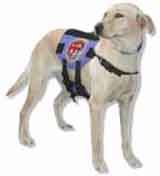Dog Behavior Problems and TrainingDog Chewing Problems |
|
|
Chewing is usually a developmental phase that puppies pass through to relieve the itch and pain of cutting new teeth. The majority of dogs stop chewing everything in sight once their new teeth are fully erupted, at about 9 months old. The few dogs that do not cease chewing by age 1, either have acquired the habit of chewing from boredom, anxiety, and frustration, or have acquired an unusual gourmet appetite. Regardless of the reason a dog chews, the behavior of chewing can be very expensive and very dangerous to the dog's physical well being. Correcting chewing, or any other behavior problem, requires that someone be present to catch the dog in the act. Showing the dog a shoe that was chewed several hours earlier and yelling at him may make you feel better, but there is little chance that he will connect the correction with the idea that chewing shoes is wrong. An unsupervised puppy left to roam the house may develop a taste for dangerous chew toys such as electrical cords, cleaning supplies, and other toxic items. The landscaped yard filled with possibly toxic plants, or rocks and wood that can obstruct the dog's intestines is a similarly dangerous environment for the unsupervised puppy. Dogs that chew and swallow rocks or other sharp objects often require costly and risky emergency surgery. To avoid mishaps when you cannot keep a watchful eye on the dog, confine him in an area where only appropriate chew items such as dog toys, rawhides, or knuckle bones are available. You must exercise caution in which chew toys are left in the crate, because dogs have been reported to choke on some toys and rawhides. If you confine your dog to a crate during unsupervised periods, you don't have to worry about him chewing up prized possessions and furniture, or doing himself harm. You may choose to dog proof the house by removing any prize possessions until the dog has passed through the chewing stage. Products such as Bitter Apple or Tabasco sauce may be sprayed on furniture and possessions to keep the dog from chewing, but check for staining before using them. Ninety-nine percent of the dogs find the taste of these products repulsive, but a few dogs think they are a gourmet delight. One product that may not be attractive to any dog is ammonia. Be careful not to spray the ammonia when the dog is close by; it could damage his olfactory system and eyes. Read the instructions carefully to determine what is safe to spray on valuable possessions. Your dog should be well supplied with acceptable chew items such as old socks, safe dog toys, rawhides, chew hooves, and knuckle bones. Only knuckle bones are safe; other bones will splinter and get caught in the dog's throat or intestines. If you are worried that your dog will not discriminate between an old chewable sock and a new sock, you may want to take time to play fetch with the dog and an old sock so the item will become his favorite toy. The old sock will carry the scent of the dog, whereas the new sock has your scent. The dog quickly learns the difference between the socks when you praise him for playing with and chewing the old sock and reprimand him for chewing on socks with your scent. Back to the Dog Behavior Problems and Training page
| |
|
Related News About Dogs ' ); // get rid of newsfeed display by carp CarpConf('poweredby',''); CarpCacheShow('http://dogguidance.com/dogblog/?feed=rss2'); ?>
|
|
|
|
|
|
Copyright © 2006-2007 dogguidance.com |


